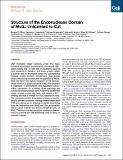Structure of the Endonuclease Domain of MutL: Unlicensed to Cut
Author(s)
Pillon, Monica C.; Lorenowicz, Jessica J.; Uckelmann, Michael; Klocko, Andrew D.; Mitchell, Ryan R.; Chung, Yu Seon; Modrich, Paul; Walker, Graham C.; Simmons, Lyle A.; Friedhoff, Peter; Guarne, Alba; ... Show more Show less
DownloadPillon-2010-Structure of the End.pdf (909.7Kb)
PUBLISHER_POLICY
Publisher Policy
Article is made available in accordance with the publisher's policy and may be subject to US copyright law. Please refer to the publisher's site for terms of use.
Terms of use
Metadata
Show full item recordAbstract
DNA mismatch repair corrects errors that have escaped polymerase proofreading, increasing replication fidelity 100- to 1000-fold in organisms ranging from bacteria to humans. The MutL protein plays a central role in mismatch repair by coordinating multiple protein-protein interactions that signal strand removal upon mismatch recognition by MutS. Here we report the crystal structure of the endonuclease domain of Bacillus subtilis MutL. The structure is organized in dimerization and regulatory subdomains connected by a helical lever spanning the conserved endonuclease motif. Additional conserved motifs cluster around the lever and define a Zn2+-binding site that is critical for MutL function in vivo. The structure unveils a powerful inhibitory mechanism to prevent undesired nicking of newly replicated DNA and allows us to propose a model describing how the interaction with MutS and the processivity clamp could license the endonuclease activity of MutL. The structure also provides a molecular framework to propose and test additional roles of MutL in mismatch repair.
Date issued
2010-07Department
Massachusetts Institute of Technology. Department of BiologyJournal
Molecular Cell
Publisher
Elsevier B.V.
Citation
Pillon, Monica C., Jessica J. Lorenowicz, Michael Uckelmann, Andrew D. Klocko, Ryan R. Mitchell, Yu Seon Chung, Paul Modrich, et al. “Structure of the Endonuclease Domain of MutL: Unlicensed to Cut.” Molecular Cell 39, no. 1 (July 2010): 145–151. © 2010 Elsevier Inc.
Version: Final published version
ISSN
10972765